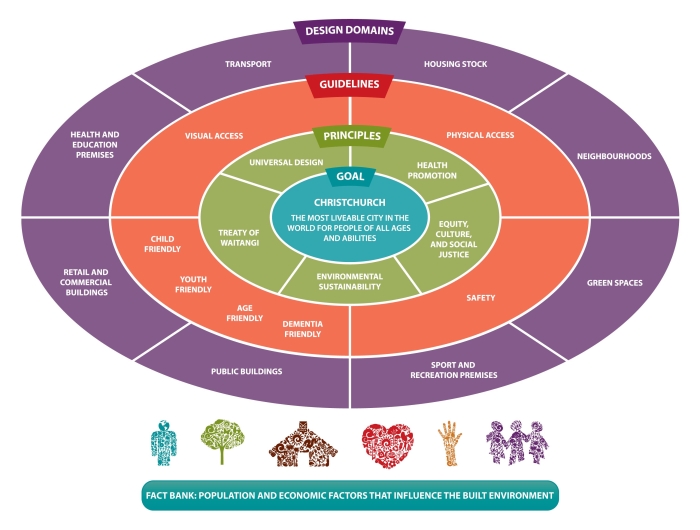
The diagram above describes the different factors that the built environment can contribute to making Christchurch the most liveable city in the world for people of all ages and abilities.
In the centre is this goal. Surrounding the goal are the principles to assist in achieving the goal: health promotion, equity and social justice, environmental sustainability, the Treaty of Waitangi and universal design.
Surrounding the principles are the guidelines used such as physical and visual access, safety, and friendliness to all ages (children, youth and elderly) and for those with dementia.
Lastly surrounding the guidelines are the design domains or settings: the parts of the built environment. This includes housing stock and neighbourhoods, green spaces, public, retail and commercial buildings, health, sport and recreation facilities, and also transport.
The Fact Bank contains relevant demographic and economic information that can inform design and building decisions.
This page contains links to resources and publications relating to each of these factors.
Your feedback on this Building for All portal is welcomed. Please send any suggestions, comments or questions, including documents to add to Allison Nichols-Dunsmuir (allison.nichols-dunsmuir[at]cdhb.health.nz).
Design Domains
Green Spaces
Health and Education Premises
Housing Stock
Neighbourhoods
Public Buildings
Retail and Commercial Buildings
Sport and Recreational Spaces
Transport
- Active Transport [Christchurch City Health Profile].
- Guidance on accessible car parking gives specifications and advice on meeting requirements for mobility parking [Department of Building and Housing and Barrier Free Trust NZ 2008].
- Pedestrian Planning and Design Guide is New Zealand's comprehensive official guide to planning and design for walking. It sets out ways to improve New Zealand’s walking environment. Addresses the varied abilities of pedestrians [New Zealand Transport Authority 2008].
- Public Transport [Christchurch City Health Profile].
Guidelines
Age Friendly
Child Friendly
Dementia Friendly
Physical Access
Safety
Visual Access
- "Let's Go! - Assisting Blind Passengers" is a video from the Association of Blind Citizens' (Southland Branch) that helps airline ground crew, taxi and bus drivers give their blind, vision impaired and deaf/blind passengers a smoother ride.
Youth Friendly
Principles
Environmental Sustainability
Equity, Culture and Social Justice
Health Promotion
Treaty of Waitangi
Universal Design
Fact Bank